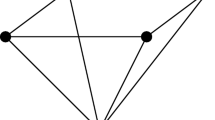Abstract
We use the residue theorem to derive an expression for the number of lattice points in a dilated n-dimensional tetrahedron with vertices at lattice points on each coordinate axis and the origin. This expression is known as the Ehrhart polynomial. We show that it is a polynomial in t, where t is the integral dilation parameter. We prove the Ehrhart-Macdonald reciprocity law for these tetrahedra, relating the Ehrhart polynomials of the interior and the closure of the tetrahedra. To illustrate our method, we compute the Ehrhart coefficient for codimension 2. Finally, we show how our ideas can be used to compute the Ehrhart polynomial for an arbitrary convex lattice polytope.
Similar content being viewed by others
References
A.I. Barvinok, “Computing the Ehrhart polynomial of a convex lattice polytope,” Discrete Comput. Geom. 12 (1994) 35–48.
M. Beck, “The reciprocity law for Dedekind sums via the constant Ehrhart coefficient,” Amer. Math. Monthly 106(5) (1999) 459–462.
M. Beck, R. Diaz, and S. Robins, “The Frobenius problem, rational polytopes, and Fourier-Dedekind sums,” Preprint, submitted.
M. Brion and M. Vergne, “Residue formulae, vector partition functions and lattice points in rational polytopes,” J. Amer. Math. Soc. 10(4) (1997) 797–833.
R. Diaz and S. Robins, “The Erhart polynomial of a lattice polytope,” Annals of Math. 145 (1997) 503–518.
E. Ehrhart, “Sur un problème de géométrie diophantienne linéaire II,” J. reine angewandte Math. 227 (1967) 25–49.
J.M. Kantor and A.G. Khovanskii, “Une application du Théorème de Riemann-Roch combinatoire au polynôme d'Ehrhart des polytopes entier de ℝn,” C.R. Acad. Sci. Paris, Series I 317 (1993) 501–507.
A.G. Khovanskii and A.V. Pukhlikov, “The Riemann-Roch theorem for integrals and sums of quasipolynomials on virtual polytopes,” St. Petersburg Math. J. 4(4) (1993) 789–812.
I.G. MacDonald, “Polynomials associated with finite cell complexes,” J. London Math. Soc. 4 (1971) 181–192.
P. McMullen, “Lattice invariant valuations on rational polytopes,” Arch. Math. (Basel) 31(5) (1978/1979) 509–516.
J. Pommersheim, “Toric varieties, lattice points, and Dedekind sums,” Math. Ann. 295 (1993) 1–24.
H. Rademacher and E. Grosswald, “Dedekind sums,” Carus Mathematical Monographs, The Mathematical Association of America, 1972.
R. Stanley, Enumerative Combinatorics, Wadsworth and Brooks/Cole, Monterey, CA, 1986.
D. Zagier, “Higher dimensional Dedekind sums,” Math. Ann. 202 (1973) 149–172.
Author information
Authors and Affiliations
Rights and permissions
About this article
Cite this article
Beck, M. Counting Lattice Points by Means of the Residue Theorem. The Ramanujan Journal 4, 299–310 (2000). https://doi.org/10.1023/A:1009853104418
Issue Date:
DOI: https://doi.org/10.1023/A:1009853104418




